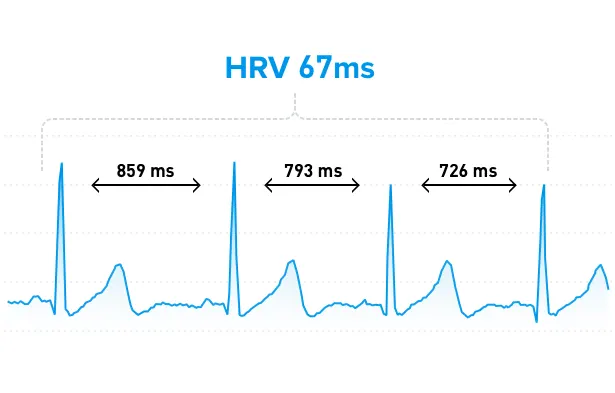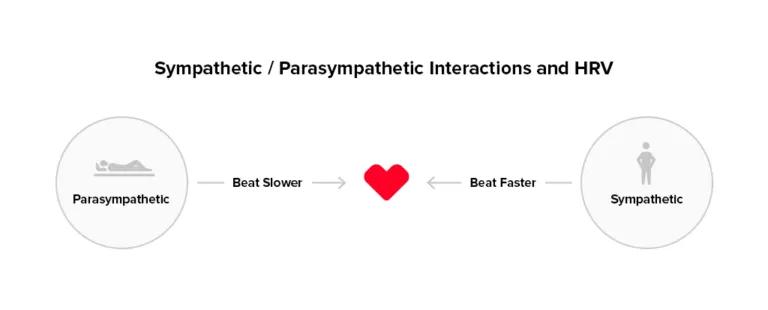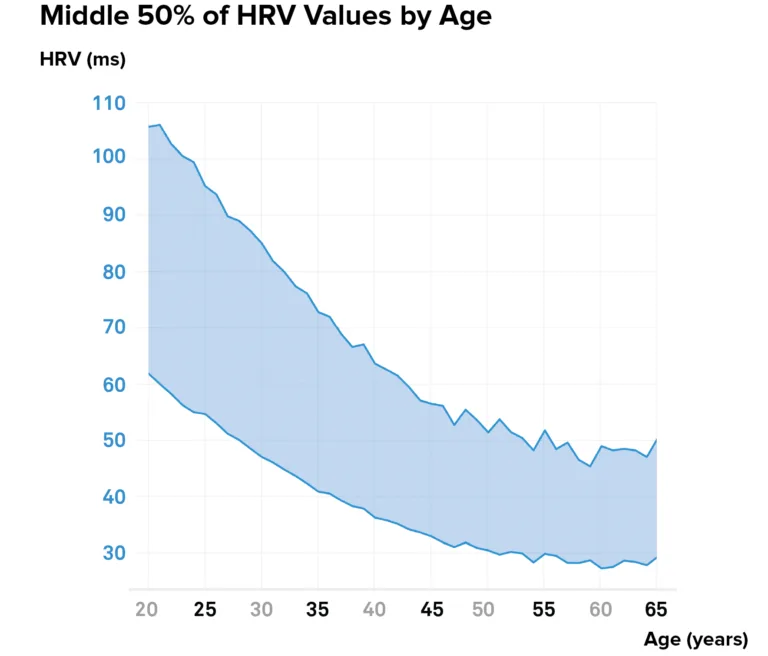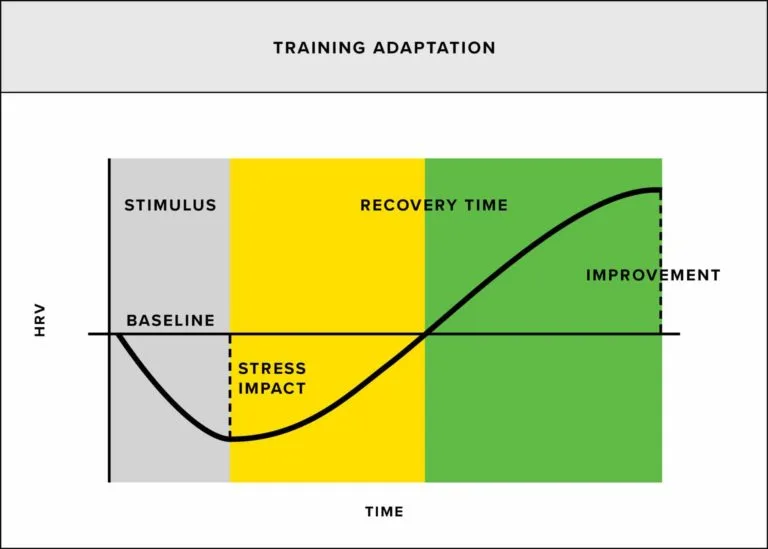Topics
- Article
- HRV
- WHOOP 101
Everything You Need to Know About Heart Rate Variability (HRV)

Heart rate variability, or HRV for short, is a measure of your autonomic nervous system that is widely considered one of the best objective metrics for physical fitness and determining your body’s readiness to perform.
What is Heart Rate Variability (HRV)?
Heart rate variability is literally the variance in time between the beats of your heart. So, if your heart rate is 60 beats per minute, it’s not actually beating once every second. Within that minute there may be 0.9 seconds between two beats, for example, and 1.15 seconds between two others. The greater this variability is, the more “ready” your body is to execute at a high level.

Heart rate variability is determined by the time between heart beats, known as RR intervals.
These periods of time between successive heart beats are known as RR intervals (named for the heartbeat’s R-phase, the spikes you see on an EKG), measured in milliseconds. WHOOP calculates HRV using RMSSD, the root mean square of successive differences between heartbeats.
HRV And The Autonomic Nervous System
Although HRV manifests as a function of your heart rate, it actually originates from your nervous system. Your autonomic nervous system, which controls the involuntary aspects of your physiology, has two branches, parasympathetic (deactivating) and sympathetic (activating). The parasympathetic nervous system (often referred to as “rest and digest”) handles inputs from internal organs, like digestion or your fingernails and hair growing. It causes a decrease in heart rate. The sympathetic nervous system (often called “fight or flight”) reflects responses to things like stress and exercise, and increases your heart rate and blood pressure. Heart rate variability comes from these two competing branches simultaneously sending signals to your heart. If your nervous system is balanced, your heart is constantly being told to beat slower by your parasympathetic system, and beat faster by your sympathetic system. This causes a fluctuation in your heart rate: HRV.

HRV is caused by two competing branches of the autonomic nervous system, sympathetic and parasympathetic.
Why is HRV a Sign of Fitness?
When you have high heart rate variability, it means that your body is responsive to both sets of inputs (parasympathetic and sympathetic). This is a sign that your nervous system is balanced, and that your body is very capable of adapting to its environment and performing at its best. On the other hand, if you have low heart rate variability, one branch is dominating (usually the sympathetic) and sending stronger signals to your heart than the other. There are times when this is a good thing--like if you’re running a race you want your body to focus on allocating resources to your legs (sympathetic activity) as opposed to digesting food (parasympathetic activity). However, if you’re not doing something active low HRV indicates your body is working hard for some other reason (maybe you're fatigued, dehydrated, stressed, or sick and need to recover), which leaves fewer resources available to dedicate towards exercising, competing, giving a presentation at work, etc. To look at it another way, the less one branch is dominating the other, the more room there is for the sympathetic (activating) branch to be able to come in and dominate, which is why high HRV suggests you’re fit and ready to go.
Learn More: Why Athletes Should Want High HRV
What is a Normal Heart Rate Variability?
Below is an average heart rate variability chart based on age:

The average heart rate variability range for WHOOP members broken down by age.
You can see that for the most part, HRV decreases abruptly as people get older. The middle 50% of 20-25 year olds usually have an average HRV in the 55-105 range, while 60-65 year olds tend to be between 25-45. And while the figure above shows what technically falls under the umbrella of “normal HRV,” answering the question “What is a good heart rate variability?” is a lot more complicated.
Learn More: Average HRV Range by Age and Gender
HRV is Highly Individualized
Heart rate variability is an extremely sensitive metric. It fluctuates greatly throughout the day, from one day to the next, and from one person to another. People often wonder “What should my HRV be?” and “How does my HRV compare to others?” Younger people tend to have higher HRV than older people, and males often have slightly higher HRV than females. Elite athletes usually have greater heart rate variability than the rest of us, and within that subset endurance athletes regularly have higher HRV than strength-based athletes. But, none of this is absolute. There are plenty of extremely fit and healthy people out there whose HRV is regularly in the 40s. What constitutes a healthy heart rate variability differs for everyone. Better questions to ask are “What is a good heart rate variability trend for me?” and “What can I do to make that happen?”
Learn More: What is a Normal HRV for Me?
Heart Rate Variability Trends are What Matters
When you begin using a heart rate variability monitor, you may notice that your HRV varies greatly from day to day. This can be attributed to the many factors that affect it (more on this shortly), and is perfectly normal. If your friend has a higher HRV than you do today, that is not an indication that they are more fit than you are. Rather than comparing your heart rate variability to others, a more practical use of HRV is to follow your own long-term trends. For example, if you’re taking steps to improve your fitness and overall health, over time you should see a gradual increase in your average heart rate variability.

A positive trend in daily heart rate variability over a 3-month time period.
Similarly, a downward trend in your HRV over several days is worth paying attention to. Among other things, it might be a sign that you’re training too hard, not sleeping enough, getting sick, eating poorly, or failing to hydrate properly.
Factors that Affect Heart Rate Variability
There are a great number of things that impact your HRV. The figure below breaks them down into three categories: Training factors, lifestyle factors, and biological factors. Training factors include the frequency and intensity of your workouts. If you go extra hard today, or for several days in a row, your HRV is likely going to take a hit. There are also many other choices you make each day (lifestyle factors) that significantly affect your heart rate variability, ranging from what you put into your body, to the quality and consistency of your sleep. And lastly, there are biological factors that are out of your control, like age, gender and genetics--some people are just born to have higher HRV than others.
How to Improve Heart Rate Variability
Methods for increasing HRV include the following:
- Intelligent Training. Don’t overdo it and push too hard for too many days without giving your body an opportunity to recover (see below).
- Hydration. The better hydrated you are, the easier it is for your blood to circulate and deliver oxygen and nutrients to your body. Aiming to drink close to one ounce of water per pound of bodyweight each day is a good goal.
- Avoid Alcohol. One night of drinking potentially decreases HRV for up to five days.
- Steady Healthy Diet. Poor nutrition has adverse effects on HRV, as does eating at unexpected times.
- Quality Sleep. It’s not just the amount of sleep you get that matters, but also the quality and consistency of your sleep. Going to bed and waking up at similar times each day is beneficial.
- Auto-Regulation. In general, trying to get your body on a consistent schedule (in particular with sleep and eating to align your circadian rhythm) is helpful. Your body does things more efficiently when it knows what’s coming.
Learn More: 10 Ways to Improve Your HRV
HRV Training
Studies have shown that heart rate variability can be a valuable tool for making the most of your training. After days of strenuous activity, your HRV will dip. With proper rest and recovery, your heart rate variability will rise, letting you know when it’s once again time to push yourself.

Intense training for several days will likely cause HRV to drop, but it will then increase when your body has time to recover.
Rather than sticking to a predetermined workout schedule, modifying the intensity and duration of your physical activity based on your heart rate variability will allow you to train smarter and more efficiently. When your HRV is high, your body is prepared to take on a greater workload. When it is low, it's a sign to cut back.
Learn More: How to Use HRV to Guide Your Training
Health and Other Applications of HRV
Beyond using heart rate variability as a fitness metric, it also has many applications when it comes to our overall health and well being. Tracking your HRV can help you gain a better understanding of:
- Nutrition
- Sleep
- Stress levels
- Mental health
- Warnings signs of sickness
- Risk of disease
For example, if your daily routine is unchanged but your HRV drops, it may be an indicator of increased stress or oncoming illness. Or, if you'd like to see the effect a new diet has on your body, the impact will be noticeable in your heart rate variability.
How WHOOP Monitors Your HRV – And How You Can Use it As a Tool
HRV is an extremely sensitive metric that varies greatly throughout the day. Tracking it 24/7 (or any time when you're active) is not very useful because it fluctuates drastically from one moment to the next. Even changes in your respiratory rate while you’re sleeping can have a significant impact on your heart rate variability. In order to get a consistent and reliable HRV measurement, WHOOP calculates your heart rate variability using a dynamic average during sleep. It is weighted towards your last slow wave sleep stage each night, the time when you’re in your deepest period of sleep. This enables you to get an accurate understanding of your baseline from which to monitor your trends. The Australian Institute of Sport (AIS) funded an independent, third-party study conducted by Central Queensland University (CQUniversity), published in Sensors, a leading international, peer-reviewed journal, examining the accuracy of six different wearable devices for estimating HR, HRV, and sleep. The study found that WHOOP is 99.7% accurate in measuring heart rate and 99% accurate* in measuring heart rate variability – levels of accuracy that surpassed all other wearables in the study.
WHOOP uses your HRV (as well as your resting heart rate, respiratory rate and sleep performance) to calculate your daily recovery–a measure of how ready your body is to perform–to help determine the daily strain you should take on, so you know how hard to push yourself, or how much you need to rest, in order to meet your fitness goals.
Learn more: For an even deeper dive into everything you need to know about HRV, check out Podcast 194: Understanding Heart Rate Variability and Its Performance Potential.
Heart Rate Variability (HRV) FAQs
What is a low HRV?
A low heart rate variability (HRV) means that the time intervals between heartbeats are more consistent and less variable than usual. This can be an indication that the autonomic nervous system, which controls heart rate and other involuntary functions, is not functioning optimally. However, the definition of "low" HRV varies depending on the individual's age, sex, and overall health.
Should I worry if my HRV is low?
A low heart rate variability (HRV) may indicate a reduced ability of the body to adapt to stress. However, a single measurement of HRV is not enough to draw conclusions about a person's health. If you are concerned about your HRV, it is best to consult with a healthcare professional for a proper evaluation and interpretation.
Is it better to have high or low HRV?
In general, a higher heart rate variability (HRV) is considered better as it indicates a more adaptable and resilient autonomic nervous system, which can respond effectively to different stressors. Conversely, a low HRV may be associated with an increased risk for various health problems, such as cardiovascular disease, depression, and anxiety. However, any major deviation outside of your typical range can represent an imbalance of the autonomic nervous system.